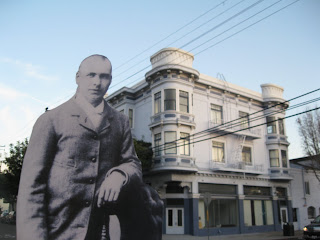Young Louis Sullivan Visits 'Paris on the Pacific'
 Master architect Louis Sullivan graduated from École des Beaux-Arts in the mid-1870s, greatly influenced by Michelangelo and his contemporaries. Not quite ready to return to Chicago, he took a time tripping graduation journey to 21st century San Francisco which he'd heard described as the "Paris on the Pacific" and was curious to see what school of temple building lodged here. As luck would have it, he landed in the Mission District, and his first view of the Million Fishes Gallery at 23rd and Bryant struck him as being a virile structure with appropriate proportions.
Master architect Louis Sullivan graduated from École des Beaux-Arts in the mid-1870s, greatly influenced by Michelangelo and his contemporaries. Not quite ready to return to Chicago, he took a time tripping graduation journey to 21st century San Francisco which he'd heard described as the "Paris on the Pacific" and was curious to see what school of temple building lodged here. As luck would have it, he landed in the Mission District, and his first view of the Million Fishes Gallery at 23rd and Bryant struck him as being a virile structure with appropriate proportions. Clean shaved, with closely cropped hair and sporting a dapper five-button coat, Sullivan fit in seamlessly as he ventured further west to the hipper parts of the Mission. For those who knew him as the bearded gentlemen of more juicy proportions when he reached his commercial and critical success in the 1880s and 1890s, he was a nearly unrecognizable artistic and could pass as just another sensitive youth whose hygiene was decidedly better than that of the skateboarders who lived in a century with far greatter access to indoor plumbing and organic grooming products.
Clean shaved, with closely cropped hair and sporting a dapper five-button coat, Sullivan fit in seamlessly as he ventured further west to the hipper parts of the Mission. For those who knew him as the bearded gentlemen of more juicy proportions when he reached his commercial and critical success in the 1880s and 1890s, he was a nearly unrecognizable artistic and could pass as just another sensitive youth whose hygiene was decidedly better than that of the skateboarders who lived in a century with far greatter access to indoor plumbing and organic grooming products. His reaction to the designs in the Mission was mixed. Though sometimes seen as a highly romantic and dramatic architect of the Victorian era, he was forward thinking enough to admire sleek modern design that could look beyond the cliches of form and function, even if they were mobile.
His reaction to the designs in the Mission was mixed. Though sometimes seen as a highly romantic and dramatic architect of the Victorian era, he was forward thinking enough to admire sleek modern design that could look beyond the cliches of form and function, even if they were mobile. Seeing the contemporary commerce nestled in the ground floors of larger towering temples of design, Sullivan recalled an essay on "how buildings learn" and thought of his own personal, physical human architecture, of how a smile line might become embedded but a beard might be removed, return and then be evicted quickly like an annoying, delinquent tenant.
Seeing the contemporary commerce nestled in the ground floors of larger towering temples of design, Sullivan recalled an essay on "how buildings learn" and thought of his own personal, physical human architecture, of how a smile line might become embedded but a beard might be removed, return and then be evicted quickly like an annoying, delinquent tenant. As he wrapped up his tour and noticed the excess of tattoos on youths in the neighborhood, Sullivan reflected on organic architecture from this passage from his Ornament in Architecture: "It must be manifest that an ornamental design will be more beautiful if it seems a part of the surface or substance that receives it than if it looks 'stuck on,' so to speak. A little observation will lead one to see that in the former case there exists a peculiar sympathy between the ornament and the structure, which is absent in the latter. Both structure and ornament obviously benefit by this sympathy; each enhancing the value of the other. And this, I take it, is the preparatory basis of what may be called an organic system of ornamentation."
As he wrapped up his tour and noticed the excess of tattoos on youths in the neighborhood, Sullivan reflected on organic architecture from this passage from his Ornament in Architecture: "It must be manifest that an ornamental design will be more beautiful if it seems a part of the surface or substance that receives it than if it looks 'stuck on,' so to speak. A little observation will lead one to see that in the former case there exists a peculiar sympathy between the ornament and the structure, which is absent in the latter. Both structure and ornament obviously benefit by this sympathy; each enhancing the value of the other. And this, I take it, is the preparatory basis of what may be called an organic system of ornamentation."Labels: architecture, Louis Sullivan, The Mission, time travel, walking



2 Comments:
Juicy proportions, indeed.
So, where'd you take him for lunch?
Salty - I took him to an obscure Basque restaurant where we were able to sit in a dimly booth in the back so our conversation would not be interrupted.
Post a Comment
<< Home